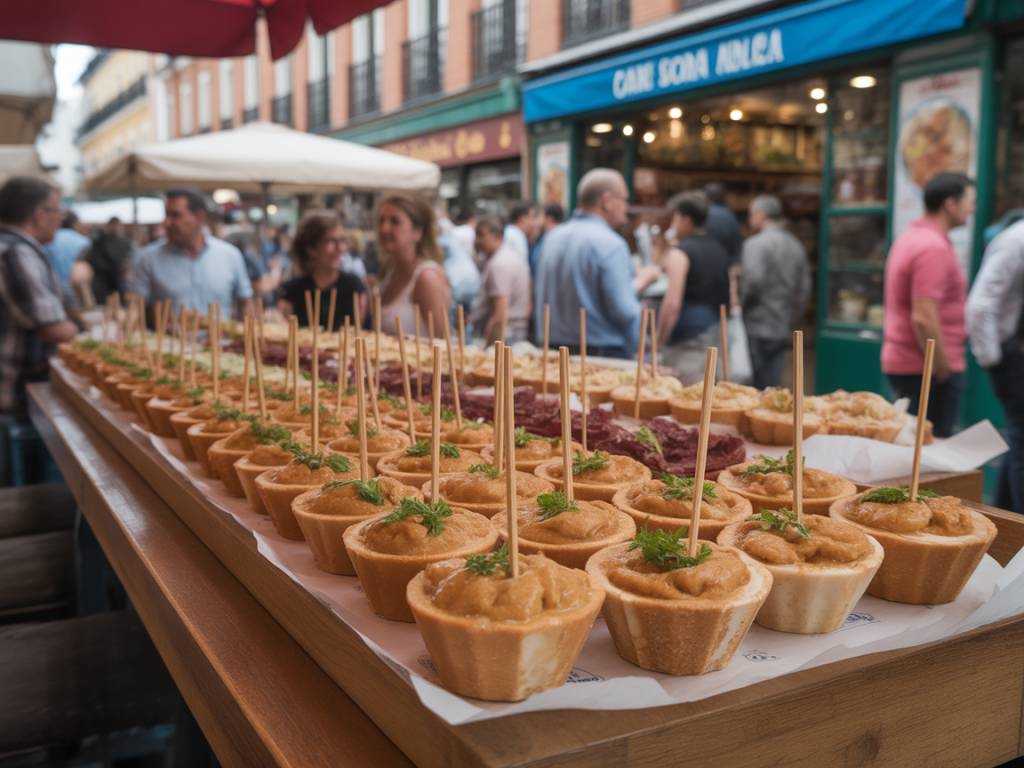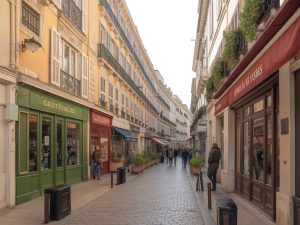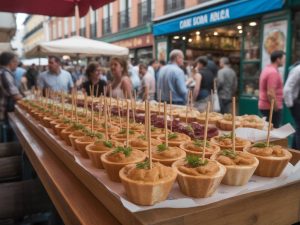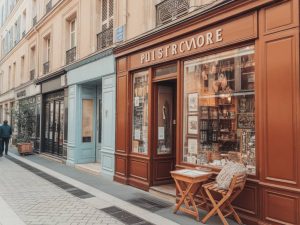Tapas Culture: The Art of Small Plates
Madrid, Spain’s luminous capital, is a vibrant city best experienced through its culinary traditions, especially tapas – those irresistible small plates that offer a bite-sized journey into Spanish gastronomy. For food lovers, dining in Madrid is less about sitting down for a formal meal and more about a flavorful stroll from bar to bar, where each establishment has its own specialty and spirited crowd of locals.
Tapas aren’t just food—they’re a way of life. Madrileños often gather with friends over tapas and drinks after work, creating an atmosphere that’s both social and deliciously informal. Unlike in some other cities, in Madrid, tapas often come free with your drink, especially in traditional taverns in areas like La Latina and Lavapiés.
Try a tortilla española (Spanish omelette) at the bustling Taberna Malaspina near Puerta del Sol, or savor jamón ibérico at the historic Bodega de la Ardosa in Malasaña. For adventurous eaters, dishes like callos a la madrileña (a hearty tripe stew) and oreja a la plancha (grilled pig’s ear) await discovery, offering authentic tastes of the capital’s culinary boldness.
The Best Markets for Food Lovers
No food guide to Madrid would be complete without a tour through its iconic markets. More than pantries for produce, these hubs are sensory playgrounds where you can meet local vendors, taste regional delicacies, and witness the rhythm of daily Madrid life.
- Mercado de San Miguel: Just steps away from Plaza Mayor, this stunning iron-and-glass building is the most famous gourmet market in Madrid. Though popular with tourists, quality is high. Sample freshly shucked oysters, croquettes, Iberian ham, and wash it down with Rioja wine.
- Mercado de San Antón: Located in Chueca, this three-level market offers an excellent mix of traditional tapas and modern dining. At the rooftop terrace, don’t miss the chance to enjoy your food with city skyline views.
- Mercado de la Paz: A gem in the upmarket Salamanca district, this lesser-known market is popular with locals. It’s the perfect place to buy local ingredients or pastry delicacies like napolitanas.
These markets not only offer a cornucopia of ingredients, but many also house small eateries and wine bars, blurring the lines between shopping and dining.
Must-Try Dishes in Madrid
Madrid has developed a cuisine as rich and varied as its history. While tapas offer small tastes, sitting down to enjoy a full dish helps you truly understand the city’s culinary soul. Here are some essential dishes to look for during your gastronomic adventure:
- Cocido Madrileño: This traditional chickpea-based stew includes a variety of meats and vegetables served in multiple courses. Casa Carola and Malacatín are particularly renowned for their hearty versions.
- Bocadillo de Calamares: A simple yet satisfying calamari sandwich is a must, especially when eaten near Plaza Mayor. Visit El Brillante near Atocha for one of the city’s best.
- Patatas Bravas: Cubes of fried potato served with a spicy tomato sauce, often found as a tapa in many bars. Docamar in the Barrio de Quintana is known for having some of the spiciest and tastiest.
- Huevos Rotos: Soft fried eggs served over a bed of fried potatoes and topped with jamón or chorizo. It’s comfort food with a Spanish twist, best enjoyed at Casa Lucio.
Pair these dishes with local wines or enjoy them with a glass of vermut, a herb-infused aperitif that has made a major comeback in Madrid’s bar scene.
Where Locals Eat: Off-the-Beaten-Path Gems
To truly connect with Madrid’s food culture, venture beyond the tourist hotspots and follow the paths Madrileños take to satisfy their appetites. Some of the most memorable meals in Madrid happen in small, family-run spots tucked away from the crowds.
In Chamberí, one of Madrid’s most charming districts, Fide is beloved for its seafood dishes and unpretentious atmosphere. Order a ración of pulpo (octopus) and let the staff guide your pairings with Spanish wines.
Venture into the Usera neighborhood for authentic Chinese-Madrileño fusion, where dumpling houses mix with tapas joints in an unexpectedly delicious harmony. Meanwhile, Tetuán is home to a variety of Latin American eateries that reflect the city’s multicultural pulse.
For a sweet finish, join the locals at Chocolatería San Ginés, operating since 1894. Its warm churros dipped into thick, velvety hot chocolate offer both comfort and tradition in every bite.
Culinary Tours and Classes
If you’re eager to dive deeper into Madrid’s food scene, consider booking a culinary tour or cooking class. These experiences provide immersive insight into local ingredients, techniques, and history—plus, you get to eat the results.
- Devour Madrid: Offers carefully curated food tours through different neighborhoods, combining tapas tastings with cultural insights.
- Cooking Point: Here you can learn how to make paella or tapas from scratch in a centrally located kitchen near Anton Martin Market.
- Madrid Food Tour by Walks: Perfect for travelers wanting to understand the stories behind Madrid’s emblematic food traditions while trying a wide array of dishes.
Many of these experiences also include visits to local markets where you’ll learn how to pick the best produce, cheese, and meat like a seasoned Madrileño.
Seasonal and Festival Foods
Madrid’s food scene shifts with the seasons, and visiting during local festivals reveals a whole new array of treats. During Holy Week (Semana Santa), streets are filled with the scent of torrijas, a cinnamon-flavored bread pudding. In December, stalls pop up selling turrón and marzipan delights, sweet traditions enjoyed over generations.
Visit during San Isidro, Madrid’s patron saint festival in May, and you’ll be able to try rosquillas – various donuts, some plain (tontas), others frosted or almond-glazed. Food is an essential part of the celebration, and many traditional dishes are served at outdoor fairs and gatherings.
Tips for Eating Like a Madrileño
- Don’t rush: Madrileños take their time with food. Relax into the rhythm—long dinners, shared plates, and extended conversation are part of the culture.
- Eat late: Lunch often starts at 2 PM and dinner around 9 PM or even later. Plan your meals accordingly.
- Order house specials: At small taverns, ask the server what dish the chef recommends. It’s often a house specialty not found on the printed menu.
- Sample slowly: Because tapas are about variety, don’t hesitate to visit multiple spots in one evening to experience the full range of local flavors.
Madrid may be a city constantly in motion, but when it comes to food, it celebrates patience, tradition, and community. Whether you’re nibbling on tapas in a centuries-old tavern, exploring bustling local markets, or sharing a homemade paella in a cooking class, you’ll find that the heart of Madrid is best discovered plate by plate.






More Stories
Les meilleures adresses vintage de Lisbonne : shopping, cafés cachés et balades au bord du Tage
Top hidden gems to visit in France on your next holiday
Exploring the lavender fields of Provence: best times and tips